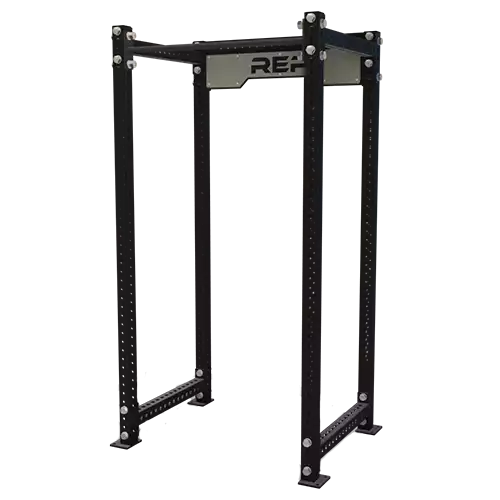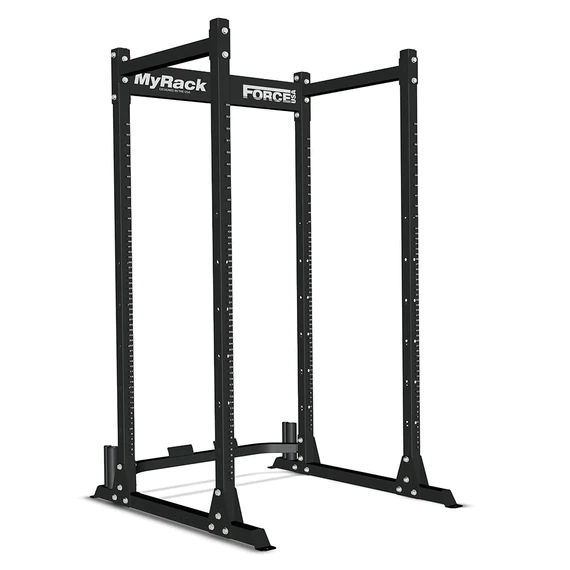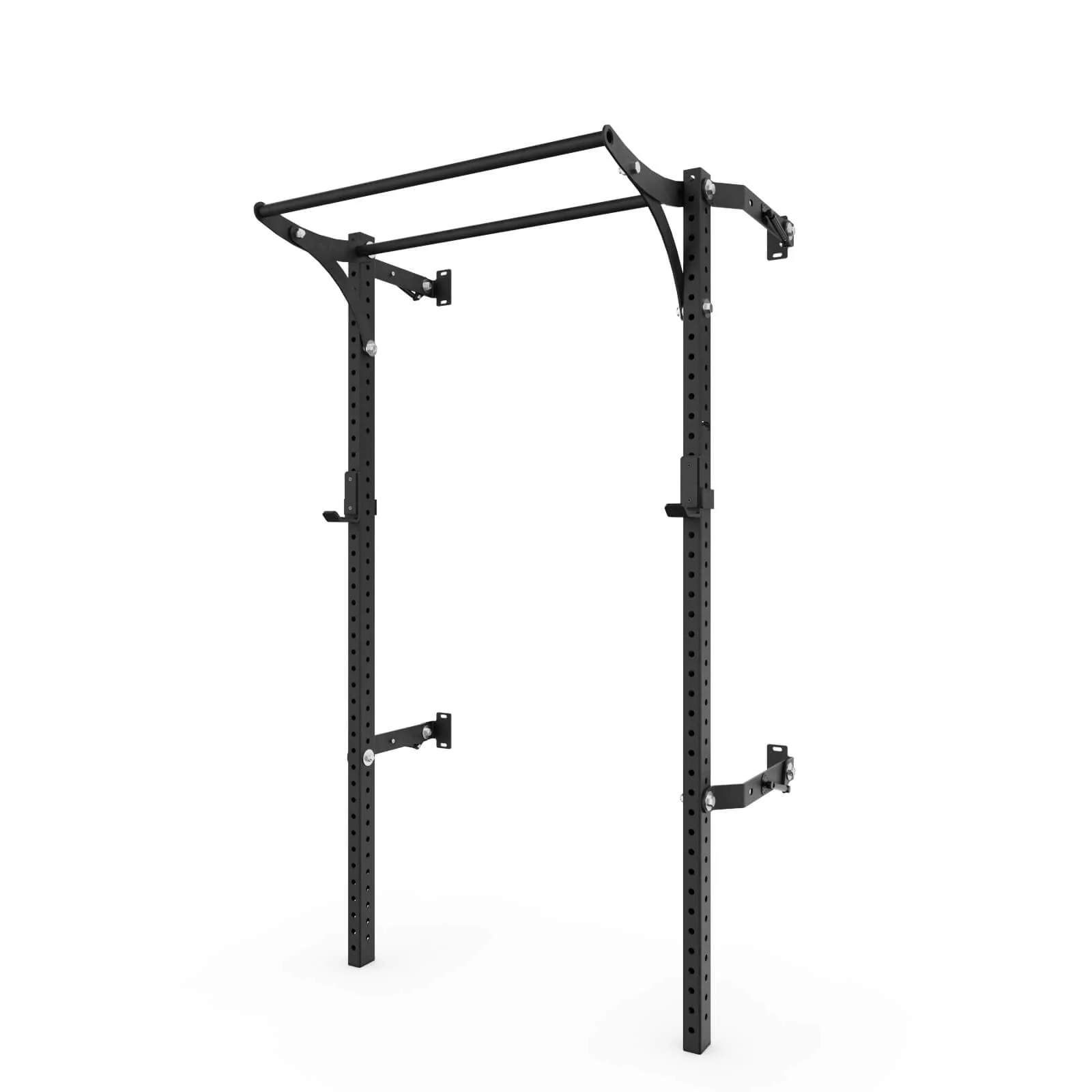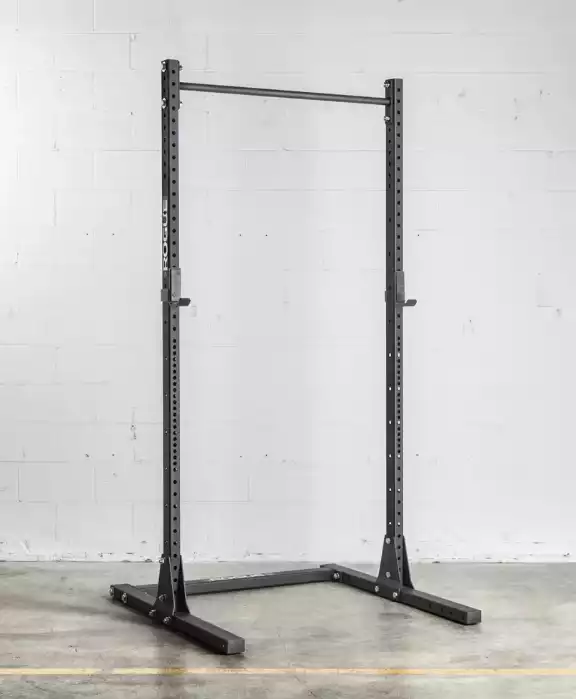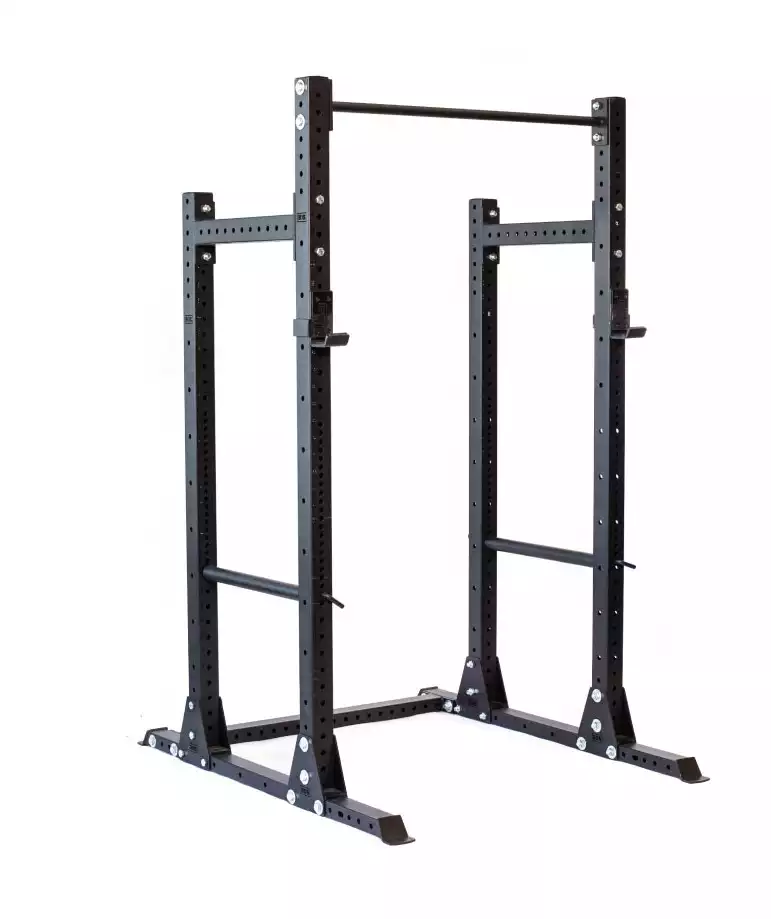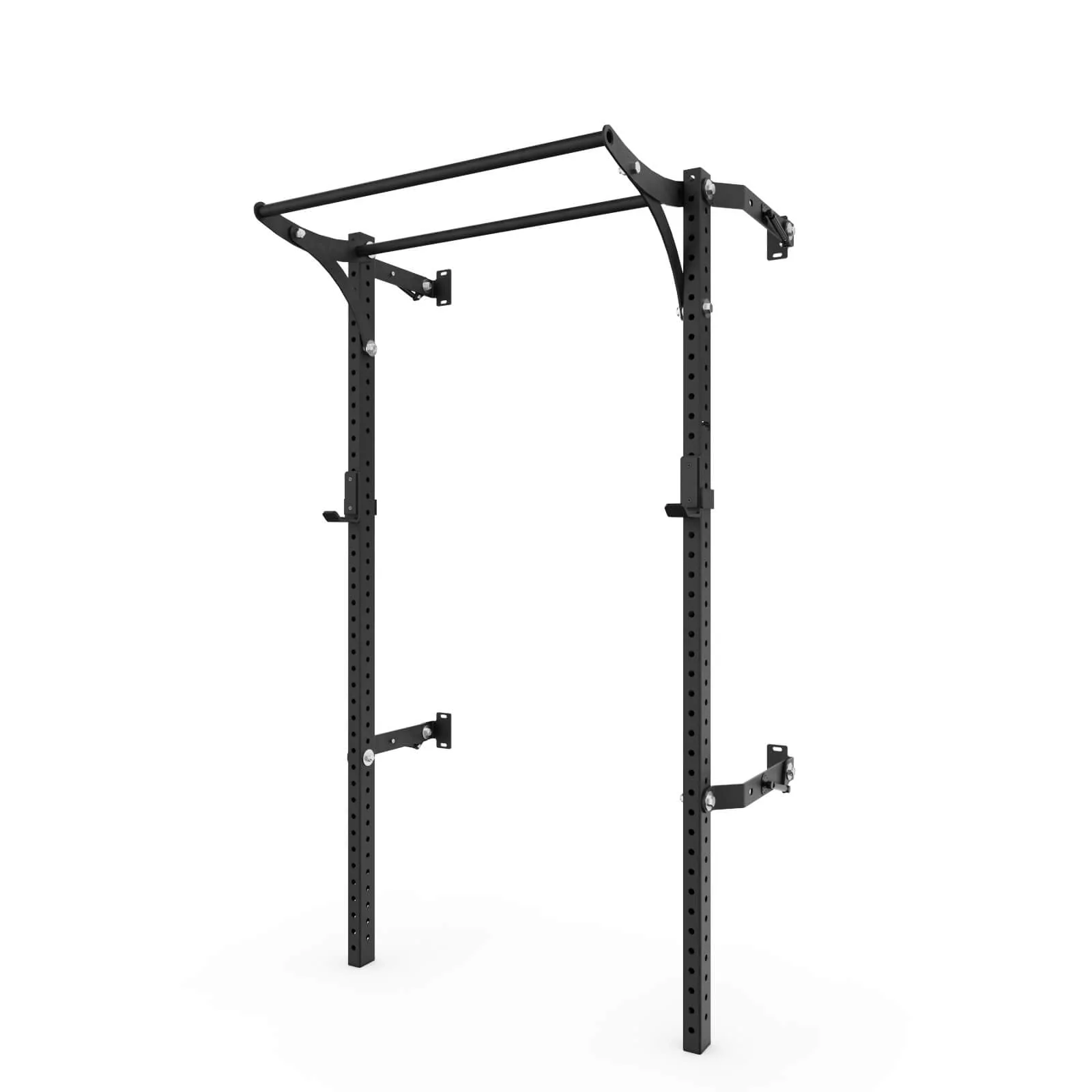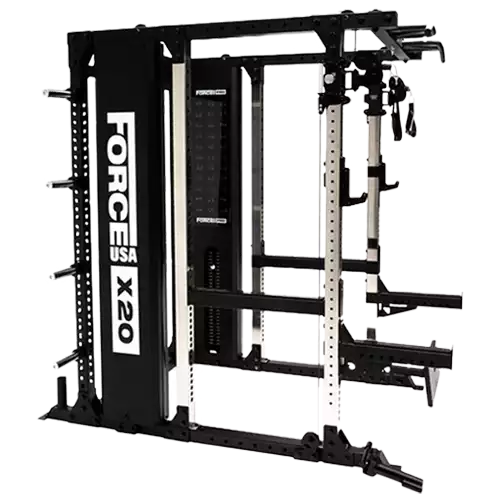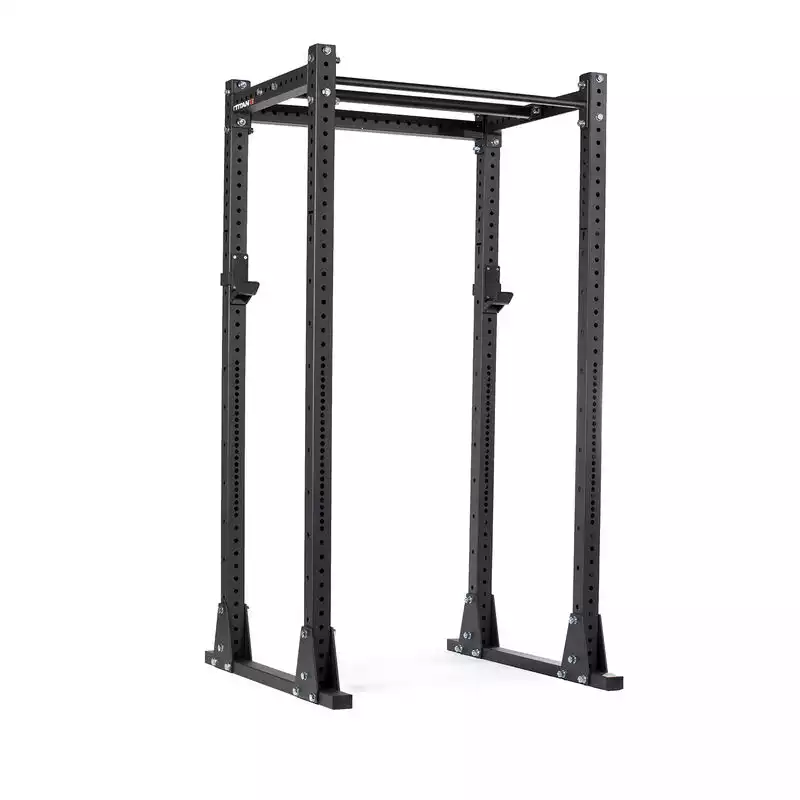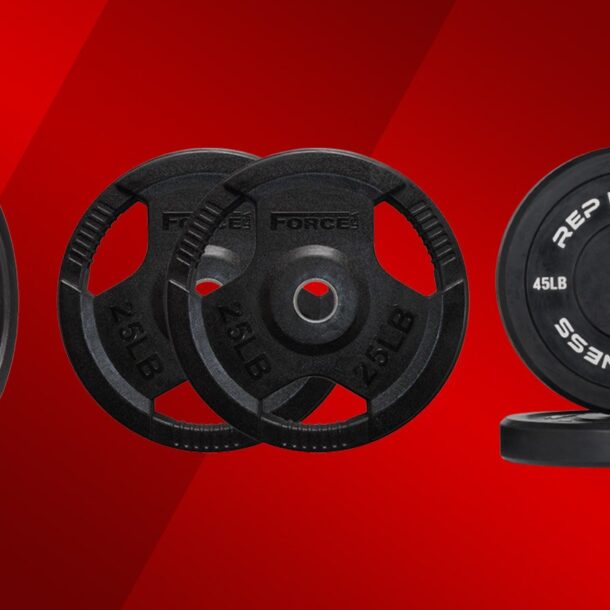
The 8 Best Squat Racks to Buy in 2023 | Breaking Muscle
We receive free products and receive commissions through our links. See disclosures page.
While there are plenty of effective, limited-equipment workouts you can do at home to stay in shape, you’ll need a squat rack if you want to lift heavy weight. Without one, you’ll struggle to perform lifts like the back squat and bench press and may never reach your full strength potential.
I bought a new squat rack about a year and a half ago. Even though I have years of training experience and am familiar with many different squat rack companies through my job as a fitness writer, it still took me weeks to make a decision. However, I learned much more about squat racks than I ever thought possible. To save you from having to endure countless hours of research, I compiled a list of the eight best squat racks below.
Our Top Picks for the Best Squat Racks
- Best Power Rack: REP Fitness PR-5000
- Best Budget Squat Rack: Force USA MyRack Modular Power Rack
- Best Foldable Squat Rack: PRx Profile One Rack
- Best Squat Stand: Rogue Fitness S-2 Squat Stand
- Best Half Rack: Bells of Steel Hydra Half Rack
- Best Squat Rack for Small Spaces: PRx Fold-In ONE Rack
- Best Squat Rack with Cables: Force USA X20
- Best Squat Rack for Beginners: Titan X-3 Power Rack
Best Power Rack: REP Fitness PR-5000
- Dimensions: 50.8 inches wide; choice of 80- or 93-inch height; choice of 16-, 30-, or 41-inch rack depth
- Materials: 3×3, 11-gauge steel
- Weight capacity: 1,000 pounds
- Hole spacing: Two inches
Pros
- Lots of customization options available
- Compatible with attachments from other brands
- Laser cut numbers on the uprights for easy and quick rack adjustments
Cons
- High starting price and the cost of attachments and accessories adds up quickly
- No Westside hole spacing
If you’re searching for a customizable, heavy-duty squat rack, look no further than the REP Fitness PR-5000. It has 3×3, 11-gauge steel uprights, which is impressive on its own. But with the number of compatible accessories and attachments available, you can have access to almost an entire gym with just this one rack. For this reason, we consider the PR-5000 the best squat rack overall.
You have the choice of an 80- or a 93-inch rack height, depending on how high your ceiling is. You can also choose a 16-, 30-, or 41-inch rack depth. The deeper it is, the more space you’ll have inside for squats. You’ll also be able to fit more attachments in the deeper racks. And, for an even more personal touch, you can choose from six colors for the uprights: red, blue, white, clear, metallic black, or matte black. The crossmembers are available in the same colors and come in green, too, so you can really make this power rack unique.
In addition, you can add several other attachments, including:
- Safety straps, pin pipe safeties, or flip-down safeties
- A straight, 1.25-diameter pull-up bar; a two-inch-diameter pull-up bar; a multi-grip pull-up bar; or a globe pull-up bar
- Flat, standard, lowered, or sandwich J-cups
- A leg roller attachment
- A dip station
- ISO arms
- A wall ball target
- A lat pulldown attachment
- And more
(If you feel overwhelmed from reading this, scroll down to the buying guide below, where I talk more about some of these features.)
The wide range of available attachments opens up your training to much more than barbell and dumbbell exercises, to which many home gym owners are limited. But as you can imagine, the attachments drive up the price, and the rack is expensive to begin with. If you can’t afford to buy everything all at once, you can skip the attachments and buy them at a later date, as REP sells all of them separately on its website.
The rack is also compatible with attachments from other brands, so you may be able to find the ones you want at a lower price from another company. The home gym sub-Reddit is a fantastic resource for mixing and matching squat rack attachments from different brands if you’re not sure what to look for.
Aside from the price, it’s hard to find any major drawbacks to the PR-5000. We do wish it came with Westside hole spacing, though. Westside hole spacing means the holes on the lower portions of the uprights are spaced one inch apart instead of two inches. The smaller spacing allows for more precise adjustments of the J-cups, so you can maintain better starting positions during bench presses when you unrack the weight. It also lets you place safety pins or straps in a more exact position.
The lowered J-cups allow you to get around this by creating one-inch hole spacing on racks with two-inch hole spacing. However, you have to pay extra for them.
RELATED: Best Trap Bars With Open Designs, Multiple Grips, and More
Best Budget Squat Rack: Force USA MyRack Modular Power Rack
Pros
- 20 customization options available
- Numbered holes on the uprights for fast and easy J-cup adjustment
- Comes with a lifetime structural warranty
- Uses 10-gauge steel brackets to bolster its stability
Cons
- Requires a ceiling height of 98 inches if you want to do pull-ups
The Force USA MyRack Modular Power Rack isn’t the cheapest squat rack around. But it is one of the lower-priced options on this list, and I wouldn’t recommend that you go much lower than its price point — just under $500 — if you want a safe, sturdy squat rack.
The MyRack Modular Power Rack consists of 12-gauge, 2.4-inch steel uprights and boasts a 2,000-pound weight capacity. It’s highly unlikely that you’d ever lift 2,000 pounds, so this rack should be able to handle any weight you put on it. It also has Westside hole spacing for more precise barbell placement and can be bolted to the floor or used as a free-standing rack. Customers have reported that it’s stable even without bolting it down, which is a plus for those who can’t drill into their floor.
Several customization options are available. You can opt for spotter arms, flip-down safety bars, or safety straps; a standard, multi-grip, or globe pull-up bar; a lat pull-down and low row station; lat pull-down and cable crossover attachments; and much more. In all, there are 20 options to choose from, so you can make the rack as basic or robust as you want.
The MyRack Modular Power Rack can fit in small spaces, as it’s just 55 inches long and 47 inches wide. It’s 87 inches tall, so it can fit under ceilings less than eight feet high. However, if you want to do pull-ups without hitting your head on the ceiling, you’ll need a ceiling height of at least 98 inches.
Best Foldable Squat Rack: PRx Profile One Rack
- Dimensions: 52″ W x 89″ H x 29.25″ D when folded down; 52″ W x 89″ H x 29.25″ D when folded up
- Materials: 2×3, 11-gauge steel
- Weight capacity: 1,000 pounds
- Hole spacing: Two inches
Pros
- Black powder coat finish for durability
- Takes up just four inches when folded
- Can choose between a standard, kipping, or multi-grip pull-up bar
Cons
- Expensive for a rack that uses 2×3 steel
- Requires a ceiling height of 107 inches to fold it up
A folding squat rack like the PRx Profile One Rack is ideal for those who work out in small rooms, park their cars in their garage gyms, or just want extra floor space when they’re not training. The Profile One Rack exploded in popularity after it appeared on season seven of Shark Tank and has become a go-to squat rack for home gym owners limited by space.
PRx doesn’t offer many customization options for the Profile One Rack, but you do have a choice between three pull-up bars: a kipping bar, a standard 1.25-inch diameter bar, or a multi-grip bar. The kipping bar is great for CrossFitters because it extends from the wall by nearly 40 inches, offering plenty of room to do kipping pull-ups and toes-to-bars. The standard bar is suitable for traditional pull-ups and chin-ups, and the multi-grip bar is a solid option if you like to vary your pull-up grip (for example, by doing neutral-grip pull-ups).
The uprights are made of 2×3 steel. This is thick and sturdy enough for most lifters, but for the price, we would have liked to see 3×3 steel. If you opt for a pull-up bar, you’ll spend at least $800, and you can find 3×3 squat racks for that price.
The other drawback is that you need a ceiling height of 107 inches to fold it up. However, when unfolded, the rack is 89 inches high. If you’re set on a wall-mounted squat rack but have short ceilings, the Profile One Rack could still be a great choice — you’ll just have to leave it unfolded, even when it’s not in use.
Best Squat Stand: Rogue Fitness S-2 Squat Stand
Pros
- Can choose between a fat or standard-diameter pull-up bar
- J-cups have plastic liners to protect against damage to your barbell
- Triangular plates at the base for extra stability
- Lots of compatible attachments available
Cons
- Requires a ceiling height of at least eight feet
Squat stands are ideal for those who don’t have room for a full power rack or those who train the Olympic lifts, as they can’t do snatches, cleans, or jerks inside a power cage. However, many squat stands are wobbly since they only have two uprights, and their bases aren’t very sturdy. That’s not an issue with the Rogue S-2 Squat Stand. It consists of 2×3, 11-gauge steel and uses the same triangular plates on the base as Rogue’s heavier-duty squat racks, which help keep it grounded.
Another feature that sets the S-2 Squat Stand apart from its competition is the pull-up bar. Not all squat stands have this and instead of J-cups at the top of the uprights for a barbell. The addition of the pull-up bar opens up the number of exercises you can do at home. You can do pull-ups and hanging leg raises or loop your favorite resistance bands around the bar for stretching and mobility work. Even if you’re a CrossFitter and do kipping movements, the rack will remain stable.
Rogue sells several compatible attachments for the S-2. Safety spotter arms allow you to squat and bench press heavy weights with more confidence when you train by yourself. The landmine and dip stations allow for more workout versatility, as you can do dips, landmine shoulder presses, or landmine squats. You can also purchase barbell and plate holders, a wall ball target, a battle rope anchor, and more.
The S-2 starts at under $500, which is reasonable for a high-quality squat rack from Rogue. Any accessories you add to it will drive up the cost, but spending the money may be worth it if you want a versatile, customizable squat rack that will fit in a small home gym.
RELATED: Best Kettlebells for CrossFit, Beginners, and More
Best Half Rack: Bells of Steel Hydra Half Rack
Pros
- Doesn’t need to be bolted down
- Three height options available (84, 90, or 108 inches)
- Two inside depths available (17 or 30 inches)
- Compatible with attachments from other brands
Cons
- Can be pricey if you add a lot of attachments
It’s rare to find a modular half rack that can accommodate more than just a couple of attachments. However, Bells Of Steel offers nearly a dozen optional attachments for its Hydra Half Rack, making it one of the most customizable half racks we’ve seen. We also love its flat-foot design, so you don’t have to bolt it down.
Potential attachments include storage horns, three different styles of J-cups (standard, roller, or monolift), and a lat pull-down system. If you’re in the market for a high-quality barbell and/or a top-notch set of bumper plates, you can add those to your purchase, too. However, the Hydra Half Rack is compatible with attachments from other brands, so you’re not limited to equipment from Bells Of Steel — just double-check the specifications to ensure the attachments will fit a rack with 3×3 tubing and ⅝-inch hole sizes.
Aside from the add-ons, there are other ways you can customize your Hydra Half Rack. For example, you can choose uprights that are 84, 90, or 108 inches, depending on your ceiling height. You can also select an inside depth of 17 or 30 inches. The 30-inch depth offers ample room for you to walk your squat out, but the 17-inch depth may be better if you have a small gym space.
There’s not much to dislike about the Hydra Half Rack, except maybe the price. It starts at around $450, and the price quickly creeps up as you add more attachments to it. However, if you’ve been wanting something that’s more stable than squat stands but smaller than a power cage, this could be the right squat rack for you.
Best Squat Rack for Small Spaces: PRx Fold-In ONE Rack
- Dimensions: 49″ L x 90″ H x 6.75″ D when folded; Unfolded: 49″ L x 90″ H x 27.5″ D when unfolded
- Materials: 2×3, 14-gauge steel
- Weight capacity: 1,000 pounds
- Hole spacing: Two inches
Pros
- Easy-to-follow installation instructions
- Takes up less than three feet of floor space when unfolded
- Powder coat finish to ward off rust and corrosion
Cons
- Ceilings need to be 91 inches or higher
- 14-gauge steel
Not everyone is fortunate enough to have large home gyms, and PRx came up with an ideal solution for those with small gym spaces: the Fold-In ONE Rack. It extends just 27.5 inches from the wall when unfolded, so you should still have plenty of room for any other home gym essentials you want to buy. Additionally, instead of folding in and up, like most foldable squat racks, it only folds in, so you don’t need super high ceilings to accommodate it.
That said, PRx recommends installing it in rooms with 91-inch ceilings or higher, which can be an issue if you want to put it in a basement with low ceilings.
PRx uses 14-gauge steel for the Fold-In ONE Rack. I generally don’t recommend squat racks made with less than 12-gauge steel because they can be thin and wobbly. However, since the Fold-In ONE rack is a wall-mounted squat rack, that helps keep it more secure. Plus, it still has a 1,000-pound weight capacity, which is sufficient for casual weightlifters.
The use of thinner steel also allows PRx to sell the Fold-In One Rack for a reasonable price. Coming in at just under $500, it’s a budget-friendly rack. It may not be sturdy enough for powerlifters, but it can be an economical option for home gym owners with limited space.
Best Squat Rack with Cables: Force USA X20
Force USA X20 Pro Multi Trainer
- Exterior dimensions: 70” W x 88.5” D x 91” H
- Interior dimensions: 39.5” W x 72” D x 86” H
- 11-gauge, 3×3 stainless steel uprights
- Two 289-pound weight stacks
- 990-pound weight capacity
- Limited lifetime structural warranty
Pros
- Comes with 17 attachments, including spotter arms, band pegs, a landmine, and various cable handles
- Combines six machines into one
- Westside hole spacing
Cons
- Expensive
- Difficult assembly process (you may want to consider paying extra for Force USA’s assembly service)
The Force USA X20 Pro Multi Trainer is more than just a squat rack. In fact, it’s one of the best home gym machines you can buy because it combines six machines into one. In just one unit, you get a power rack, a pull-up station, a functional trainer, a suspension trainer, a low row station, and a landmine station. Having all of these capabilities gives you a ton of workout variety, as you won’t be limited to barbell and dumbbell exercises.
Two 289-pound weight stacks are located on either side of the machine. They have a two-to-one ratio, meaning 100 pounds feel like 50 because the cable travels twice as far as the weight stack. This allows you to use the machine for quicker movements since the cable is more responsive.
The frame is made with 11-gauge steel and has a 992-pound weight capacity. The weight capacity includes the weight of your barbell, the plates you load the barbell with, and any plates you leave on the storage horns. Still, 992 pounds is much more than most people can lift. Unless you’re gunning for a world-record lift, you shouldn’t have any issues using a lot of weight on this machine.
As you can probably imagine, a machine like this isn’t cheap — expect to pay over $4,000 before taxes and other fees. But even though this is a large investment, you won’t have to pay for multiple machines. When you tally up the prices, multiple machines can easily cost the same as (or more than) the X20. You’ll also never need to visit a commercial gym, so you’d save money by not having to pay for a gym membership.
Best Squat Rack for Beginners: Titan X-3 Power Rack
- Dimensions: 50.8 inches wide; choice of 80- or 93-inch height; choice of 16-, 30-, or 41-inch rack depth
- Materials: 3×3, 11-gauge steel
- Weight capacity: 1,000 pounds
- Hole spacing: Westside
Pros
- Available in two heights (82 or 91 inches)
- Option to add weight plate storage pegs for an additional cost
- Compatible with lots of accessories from Titan and other brands
- Westside hole spacing
- Powder coat finish for protection against rust and corrosion
Cons
- Doesn’t come with safety pin pipes or straps
- The holes on the uprights aren’t numbered
At first glance, the Titan X-3 Series Power Rack may not seem like a beginner’s squat rack. It’s pricey, and those new to lifting may not want to spend the money if they’re not sure how long they’ll stick with a strength training routine. The rack is also beefy, with a 3×3, 11-gauge steel construction and a 1,650-pound rackable weight capacity. But I always recommend that new lifters consider getting sturdy, quality products from the start. It’ll save them from having to replace a lot of equipment as they get stronger. The Titan X-3 Series Power Rack is definitely something you can grow into.
I’ve had this power rack for about a year and a half, and I love it. I’ll never lift anywhere near the rack’s max weight capacity, but when I decided to upgrade from the cheap squat stands I had before, I knew I wanted something rugged and versatile. I vary my workouts between strength training and CrossFit, so it was important that my new squat rack was suitable for both. The rack also lives in my garage, which gets very cold in the winter and very humid in the summer, and I needed a rack with durable materials. So far, there are no signs of rust or corrosion on my Titan X-3.
My husband and I assembled it together, and it took a couple of hours — though that’s to be expected for something that weighs almost 300 pounds. You’ll need to think carefully about where you want to put it because once it’s in place, you likely won’t be able to move it.
The rack comes with two height options: 82 and 91 inches. I’m 5’8 and have long arms and legs, and I picked the higher rack so I wouldn’t hit my head on the ceiling at the top of a pull-up. It fits perfectly under the 94-inch high ceiling in my garage.
Unlike some power racks that must be bolted down for stability, the Titan X-3 features a flat-foot design that requires no bolting to the floor. Even though I’m a bigger lifter, I never worry about it wobbling when I use it. However, if you’re concerned about stability, you can get the optional plate storage pegs. The weight from the plates will help keep the rack grounded. Note, though, that the stored plates can get in the way during bench presses, especially if you store a lot of large bumper plates.
I also like that the Titan X-3 is compatible with attachments from Titan or other brands. For example, I bought safety straps from Rogue that fit on the rack well. I wish the uprights had laser-engraved numbers, but I mark the different holes for where my J-cups need to be for squats and bench presses with painter’s tape. I occasionally have to replace the tape, but it doesn’t leave sticky residue behind. It’s an easy, cheap workaround for the lack of engraved numbers that allows me to quickly adjust the J-hooks without counting holes.
How We Chose the Best Squat Racks
Before deciding on the best squat racks, we first considered the needs of our readers and narrowed down our selections to the racks that are suitable for as wide an audience as possible. The list above includes squat racks at a wide range of price points, so you can find one that works for you regardless of your budget. We also considered various training goals and offered space-saving squat racks for those with limited space.
Furthermore, we know that brand reputation is important to many consumers. We only selected squat racks from brands we’ve purchased from before, so we can attest to the quality of their products.
Benefits of Using a Squat Rack
Whether you’re a powerlifter, Olympic weightlifter, CrossFitter, bodybuilder, or general fitness enthusiast, a squat rack is an essential piece of equipment. Below are four strong reasons to add a squat rack to your home gym:
- Easier to perform heavy lifts. Without a squat rack, back squats become much more difficult. You’d have to load the barbell on the floor, clean it to your shoulders, then press it overhead and carefully lower it to your back for back squats. Or you’d have to find a strong, elevated surface on which to load the barbell, which not everyone has available at home. A squat rack lets you place the barbell in an ideal position where you can load it and set it on your back comfortably. It also allows you to set the barbell in place for overhead presses and bench presses.
- Safety. Since you can use spotter attachments on nearly all power racks and many squat stands, lifting with a squat rack is much safer than lifting without one. If you have to drop the weight, the safety attachments will catch it, preventing severe injuries and damage to your floor.
- Versatility. Even though they’re called “squat” racks, you can do much more than squat with them. Bench presses, overhead presses, and rack deadlifts are all possible on squat racks because you can adjust the J-cups to various positions for your barbell. Depending on which squat rack you buy, you may be able to add lat pulldown attachments, dip stations, wall ball targets, or other attachments to perform even more exercises at home.
- Storage options. Most brands often recommend not leaving their barbells on the floor, as dust, dirt, and other debris can get stuck on them. I’ve even had a spider try to make a new home for itself on my barbell when I accidentally left the bar on the floor in my garage for several days. A squat rack doubles as barbell storage since you can leave it on the rack (without plates loaded on it) when you’re done working out. Some squat racks also have compatible storage pegs for you to store your plates.
What To Look For When Buying a Squat Rack
What are some features to look for in a squat rack? Well, it can be a robust piece of equipment, so there’s a lot to think about before you buy one. Below are the most important factors to consider when shopping for a squat rack.
Type of Squat Rack
The squat rack category is broad. When shopping for a squat rack, it helps to narrow down the type of squat rack that will be best for your needs.
Four of the most common types of squat racks include the following:
- Power rack – Power racks are also called power cages. They have at least four uprights, multiple crossmembers for stability, and a pull-up bar. You can add many attachments to them, enhancing their versatility. Because lifters typically put safety straps or pin pipe safeties in power racks, they are also safer for heavy lifting.
- Squat stand – Squat stands have just two uprights, making them suitable for small home gyms. Some, like the Rogue S-2 Squat Stand, have pull-up bars and/or horizontal stabilizer bars to help prevent wobbling. Others are independent stands that are easy to move around your gym.
- Half rack – Half racks are a cross between squat stands and power racks. They typically have two tall uprights joined together with a pull-up bar at the front and two shorter uprights that extend out from the back. They tend to be more stable than squat squats but don’t take up as much room as full power racks.
- Foldable squat rack – I recommend a foldable squat rack for garage gym owners who also park their cars in their garages. You mount it to a wall, then unfold it for your workout and refold it when you’re done training. When folded, foldable squat racks stick out just a few inches away from the wall.
Price
The price range for squat racks is quite large, with some costing less than $400 and others costing more than $2,000. Once you settle on the type of squat rack you want, decide how much you’re willing to spend. In general, squat stands are cheaper than power racks because they have fewer uprights, so less steel is needed to make them. But the Force USA MyRack Modular Power Rack, for example, starts at around the same price as the Rogue S-2. Factors like the steel gauge, manufacturing location, and how many attachments you add to your purchase will affect the price.
Also, don’t forget about shipping. Some brands like REP and Titan offer free shipping on all purchases as of this writing, but Rogue charges over $50 to ship the S-2, depending on where you live.
Materials
The best squat racks are made with heavy-duty steel. When looking at a rack’s description, you’ll see specifications such as 11-gauge steel or 3×3 uprights. These refer to how thick the steel is and how wide and long the uprights are.
When it comes to measuring steel, the lower the number, the thicker it is. Most squat racks designed for home gym usage are made with 11- and 12-gauge steel. Some are made with 14-gauge steel, but I don’t recommend them because they can feel flimsy and unstable.
You’ll likely also find that most home gym squat racks are made with 2×3 or 3×3 steel. Either one is sufficient for most lifters, though powerlifters, strongmen/strongwomen, and other elite athletes may want to consider 3×3 steel. The thicker steel will withstand heavy abuse for a longer period of time.
Stability
Some racks require bolting to the floor to ensure they won’t tip over. Others have flat-foot designs with wide bases that are stable on their own and don’t need to be bolted. The amount of weight you’re capable of lifting and the exercises you’ll perform most often will dictate which type of rack you should get. For example, CrossFitters who do kipping pull-ups and toes-to-bar may want a rack that can be bolted to the floor to prevent it from wobbling.
If drilling into your floor isn’t an option, consider a rack that enables you to add plate storage pegs. The plates will help weigh it down.
Hole Spacing
Hole spacing refers to how far apart the holes on the uprights are. Most squat racks have two-inch hole spacing throughout, but others have Westside hole spacing.
Westside hole spacing means the holes are two inches apart near the top, then change to one inch apart towards the middle, and go back to two inches at the very bottom. This feature is especially beneficial for bench pressing because it allows for more precision when adjusting the J-cups. As a result, racking and unracking the barbell becomes much easier.
Another benefit is that you can set your safety bars or straps to a more precise position. One inch can make a big difference when you’re about to fail a heavy squat or bench press.
The drawback is that racks with Westside hole spacing can cost around $100 more than racks without it. Most lifters will be just fine without it, but powerlifters, bodybuilders, and anyone else who bench presses often may appreciate the shorter distance between the holes.
Weight Capacity
I recommend looking for a squat rack with a weight capacity of at least 700 pounds. Even if you know you’ll never lift anywhere close to that amount of weight, the racks that can handle that much weight are much sturdier and more durable. You’ll feel more confident loading your barbell for heavy squats and bench presses, and it won’t wobble when you rack and unrack the weight or do pull-ups (if your squat rack has a pull-up bar).
Safety Features
Safety should always be your first priority when lifting, especially if you train by yourself and push heavy weights often. Look for squat racks that come with safety features that will catch the barbell if you have to fail a lift.
For power racks (and some half racks), you can choose between various types of safeties:
- Pin pipe safeties are thin bars that you slide through the holes in your squat rack’s uprights. They can hold a lot of weight, but they can become dented if you drop heavy barbells on them often. I’ve also heard lifters complain that the metal-on-metal contact makes a lot of noise and ruins the knurling on their barbells.
- Safety straps are made from a material similar to that used for seat belts. They won’t ruin the feel of your barbell or cause as much noise when you drop a loaded barbell on them.
- Flip-down safeties look like smaller versions of a squat rack’s uprights. You slide them into the uprights like a J-hook, flip them down to get them into the proper position, and secure them with a pin. Some brands like REP Fitness add a protective liner to their flip-down safeties to prevent the issues that can arise from metal-on-metal contact.
Since squats only have two uprights, you can’t use the safeties above with them. Instead, you’ll have to look for spotter arms that latch onto the uprights and extend out by a couple of feet.
Even if your squat rack purchase doesn’t include safety attachments, you can (and should) purchase them separately. As an added bonus, safety bars and straps also allow you to add more exercises to your training routine. For instance, setting them to a lower position enables you to do rack pulls. Or you can set them to the height you’d be at when you’re at the bottom of a squat and do pin squats.
Attachments
If adding more versatility to your workouts is important to you, or if you need space-saving solutions so you have more room to train, consider a squat rack that you can add various attachments to.
Here are some attachments you may want to have (note that this isn’t an exhaustive list):
- Dip bars for tricep dips
- ISO arms, which are two levers with handles at the end that enable you to do exercises you’d normally only be able to do with a machine. Chest presses are one such movement.
- A leg roller attachment so you have a stable, comfortable surface to rest your rear foot on during Bulgarian split squats. You can also use it to keep your legs secure when doing seated upper body movements.
- A wall ball target, which can come in handy if you do CrossFit at home
- A lat pulldown attachment so you can isolate your lats when training at home
- Two-inch pull-up bars, which are larger than the standard 1.25-inch pull-up bars and challenge your forearms and grip strength more
- Multi-grip pull-up bars that enable you to do neutral-grip (palms facing each other) pull-ups
- Barbell storage hangers
- Weight plate storage pegs
Many of the attachments above are often only available with power cages like the REP Fitness PR-5000. However, some squat stands, like the Rogue S-2, are compatible with spotter arms, a dip station, a landmine, and barbell and plate storage attachments. Do your research to ensure the rack you want is compatible with various attachments.
Footprint
Squat racks take up a lot of room. The Titan X-3 Power Rack, for example, has a footprint of 50 inches by 48 inches. Aside from ensuring your space is large enough for the rack itself, you need to ensure you have room on the sides — at least a couple of feet — to load and unload your barbell. And if you get a rack with a pull-up bar, you’ll need about a foot of clearance at the top to avoid hitting your head on the ceiling.
Before I bought my Titan X-3, I used tape to block out how much space it would require. This allowed me to visualize where in my garage it would fit best. I’m happy I did this because once I had the tape down, I realized that the rack wouldn’t have fit where I originally wanted to put it. Most squat racks are difficult to maneuver, so I recommend doing the same thing I did before making your purchase.
If you’re really tight on space, consider getting a folding squat rack. Even when it’s unfolded, it should only take up about four feet of space. Then, when you refold it at the end of your workout, it will only stick out a few inches from the wall.
Final Thoughts
A squat rack is the hallmark of home gyms and commercial gyms alike, and the decision of which one to buy should not be made lightly. Your training style, experience level, available space, and budget must all be considered before settling on the best squat rack for you. After that, you have to decide which style of squat rack you want and think about whether or not you want to add attachments to it.
The process can feel confusing and overwhelming, but the list of squat racks and the buying guide above have you covered. Use this information as a resource to narrow down your options, and you’ll be squatting from the comfort of your own home in no time.
FAQs
What is the best squat rack?
The best squat rack for you will depend on several factors, such as the materials, weight capacity, dimensions, and available-add ons. That said, we recommend the REP Fitness PR-5000 because you can add various attachments to it, it has a 1,000-pound weight capacity, and it’s made with 11-gauge, 3×3 steel.
What type of material is the best squat rack made out of?
The best squat racks are made of 3×3, 11-gauge steel. You can also find high-quality squat racks with 2×3 steel or 12-gauge steel. We don’t recommend 14-gauge steel for squat racks, as it’s thinner and not as sturdy. Some squat racks made for commercial gyms are made with 9- or 7-gauge steel, but this may be overkill for most home gym owners.
Are cheap squat racks safe?
Cheap squat racks can be safe if you use them properly and don’t load them beyond their listed max weight capacity. However, they may be unsteady when racking or unracking the barbell, as they are typically made with thinner steel or weaker materials like aluminum.
If you plan on lifting more than 500 pounds frequently, a more expensive squat rack may be worth it. It will typically consist of heavier-duty materials and remain more stable as you use it.
What is the best height for a squat rack?
The best height for a squat rack depends primarily on how tall you are. Squat racks range in height from 72 to 108 inches. The one you buy should be tall enough that you can set the J-cups to a good position for loading a barbell on your back without having to bend your knees too much.
What is the best budget power rack?
The best budget power rack is the Force USA MyRack Modular Power Rack. The uprights consist of 12-gauge steel, which helps keep the cost low, but the brackets are made of 10-gauge steel to help keep it stable. The MyRack Modular Power Rack also has 20 customization options available. Even though those add-ons increase the price, you’ll still pay less than if you went with a competitor.
Related Articles
2023 Healmyselfnow @ All Rights Reserved
